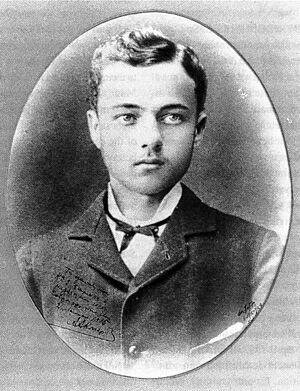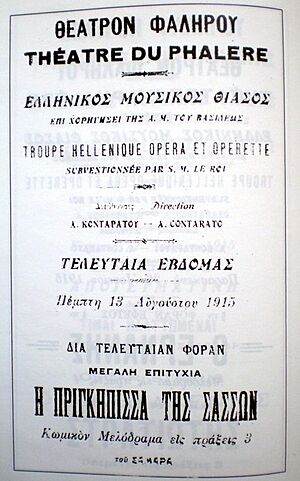Spyridon Samaras facts for kids
Spyridon-Filiskos Samaras (also known as Spyros or Spiro Samára) was a famous Greek composer. He was born on November 29, 1861, and passed away on April 7, 1917. People especially admired his operas, which are musical plays. He was one of the composers who came before the well-known Giacomo Puccini. His music was popular all over the world during his lifetime. Many consider him the most important composer from the Ionian School of music. He also wrote the music for the Olympic Hymn. The words for this hymn were written by the Greek National Poet Kostis Palamas. Some of his famous operas include Flora mirabilis (1886) and Mademoiselle de Belle-Isle (1905).
Biography
Spyros Samaras was born in Corfu, an island in Greece. His mother was from Constantinople, and his father, Skarlatos Samaras, was a diplomat from Siatista. A diplomat is someone who represents their country in other nations.
As a young man, Spyros studied music with Spyridon Xyndas. From 1875 to 1882, he attended the Athens Conservatory. There, he learned from teachers like Federico Bolognini and Angelo Mascheroni. His very first opera, Torpillae, was shown in Athens in 1879. This opera is now lost.
In 1882, he moved to Paris, France, to study at the Paris Conservatoire. He became a favorite student of the famous composer Jules Massenet. Other teachers he had included Léo Delibes and Charles Gounod. Samaras worked successfully as a composer in Paris for three years. Then, in 1885, he moved to Italy.
Samaras quickly became an important person in the opera world in Italy. His opera Flora mirabilis first played in Milan in 1886. In 1888, his opera Medgé was successfully performed in Rome. A famous French opera singer, Emma Calvé, played the main role.
He worked closely with Edoardo Sonzogno, a publisher in Milan. Sonzogno started a new theater called the Teatro Lirico Internazionale. He chose Samaras's opera La martire for the theater's grand opening on September 22, 1894. This opera had first been shown earlier that year in Naples. It was based on a story by Luigi Illica and allowed Samaras to show his unique musical style.
Samaras's works were very popular and performed widely. His operas were staged in many cities. These included Paris, Berlin, Vienna, and various cities in Greece and Italy. He wrote fifteen stage works in total. The last three were based on stories by Paul Milliet. These were Storia d'amore o La biondinetta (1903), Mademoiselle de Belle-Isle (1905), and Rhea (1908). The beginning music for Rhea used the same fanfare as the Olympic Hymn.
In 1911, Samaras returned to Greece. He thought he would become the director of the Athens Conservatoire. However, he was not chosen. This was partly because of a disagreement called the "National School controversy." Some composers believed that composers from the Ionian School, like Samaras, were too influenced by Italian music.
To support himself, he started writing operettas. Operettas are lighter, shorter operas. He wrote these to please many different audiences. His last opera, Tigra, was never finished, even though it contained some of his best music.
Samaras was chosen by Demetrius Vikelas to compose the Olympic Anthem. The words were written by Kostis Palamas. The Anthem was first performed at the opening ceremony of the 1896 Summer Olympics. These were the first modern Olympic Games.
However, the Olympic movement largely forgot the anthem for the next 50 years. In the 1950s, there was a competition to find a new anthem. But many people did not like the chosen work. In 1958, the anthem was performed again at an Olympic meeting in Tokyo. A Japanese Olympic Committee member, Ryōtarō Azuma, had received the music from Greece. With encouragement from Prince Axel of Denmark, the International Olympic Committee declared it the official anthem in 1958. It has been used at every Olympic opening ceremony since the 1960 Winter Olympics.
Samaras passed away in Athens at the age of 55. He is buried in the National Cemetery, close to the stadium where the 1896 Games took place.
Compositions
Samaras wrote many different types of music. Here are some of his complete works for the stage and some piano pieces.
Complete Stage Works
Opera
- Torpillae: Music for a play, Athens, 1879.
- Olas: An opera in 4 acts, now lost, 1882.
- Flora mirabilis: An opera in 3 acts, performed in Milan, 1886.
- Medge: An opera in 4 acts, performed in Rome, 1888.
- Messidor: An opera based on a novel, written before 1891, now lost.
- Lionella: An opera in 3 acts, mostly lost, performed in Milan, 1891.
- La martire: An opera in 3 acts, performed in Milan, 1894.
- La furia domata: An opera in 3 acts, based on Shakespeare's The Taming of the Shrew, performed in Milan, 1895.
- Storia d’amore o La biondinetta: An opera in 3 acts, performed in Milan, 1903.
- Mademoiselle de Belle-Isle: An opera in 4 acts, performed in Genoa, 1905.
- Rhea: An opera in 3 acts, performed in Florence, 1908.
- Tigra: An unfinished opera in 3 acts, only Act 1 exists, 1911.
Operetta
- Pólemos en polémo: An operetta in 3 acts, Athens, 1914.
- I pringípissa tis Sassónos: An operetta in 3 acts, Athens, 1915.
- I Kritikopoúla: An operetta in 3 acts, Athens, 1916.
Selected Piano Music
- Scènes Orientales, Quatre Suites caractéristiques, Paris, 1882
- Bohémienne, 1888
See also
 In Spanish: Spyridon Samaras para niños
In Spanish: Spyridon Samaras para niños




